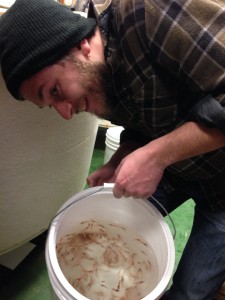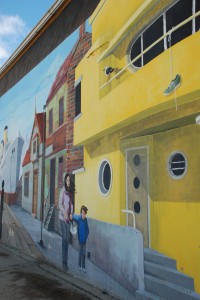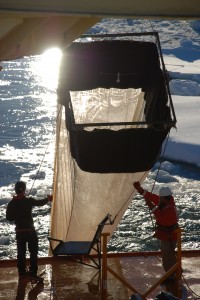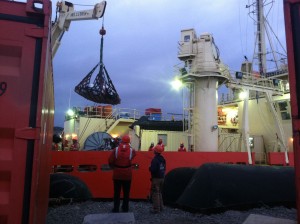In my biology class we have played a game. There were four characters that we have gotten to choose from. The characters included an Adelie penguin, a Humpback Whale, Mackerel Icefish, and the Cape Petral. The goal of the entire game was to see who would survive. It is relevant because it teaches us about the food situation in Antarctica.
The point of the game was to see who could survive. Now, we all have those friends that decide to be the one who wants to eat all the krill when he could actually eat the salps. There was only one character that could eat the salps and that was the Cape Petral. We were supposed to go around the table and eat our certain amount. I was the Adelie penguin and I was fortunate enough to survive along with the Cape Petral player. Daniel J.
Archive | January, 2014
Brine Shrimp
In the last few weeks in biology we have been conducting an experiment. We had to grow brine shrimp and collect data throughout their growth. It was rather hard to do because the information was hard to follow. The main things we checked with the brine shrimp was the pH of the water and we also checked the temperature frequently.
This experiment was a colossal pain when your group members do not want to help always. It was a good way for us to come together as a group afterwards, and for us to work as a team. The average pH for our different types of water was at about a 6-7. This was a good experiment for us to learn about how the water affected the growth of the shrimp. Although we had no success with the survival of the shrimp, we were still able to gather all the information we needed. Daniel J.
brine shrimp
The brine shrimp that we grew in the class room were supposed to represent the krill in the ocean. We found that the shrimp died every day and that it was very hard to keep them alive because there was so many of them. It is important to know how the population of krill in the ocean rises and falls in the years that pass it is relevant for the scientists to know so that they can study what happens to the animals that feed on these little shrimp.
The experiment that we had conducted was not entirely easy to do in the small; amount of space and the lack of heat needed for the brine shrimp to grow properly. We found that at least one or two of the small shrimp died each day and that they were not being fed any food so that probably did not help either. We also found that without the proper care and food that the brine shrimp did not live in a controlled enough environments for them to survive. The brine shrimp had changed in size but their size did not drastically change like the whole class had hoped. The whole class had hoped that none of the shrimp would die over the course of this experiment.
To further explore how this experiment works just buy your own brine shrimp and use vinegar and water and three bottles and conduct your own experiment. But be careful on what you use as containers to hold the brine shrimp because certain containers can cause them to die faster. This experiment is very time consuming so be sure to have plenty of time to do it. Eric M.
Brine Shrimp
The Brine Shrimp experiment was done to see if we could grow the shrimp in either, water, vinegar, or warm water and vinegar. Some groups had success with this though some did not. The brine shrimp would either grow or die and most of the shrimp died. The different bottles of brine shrimp would all have different outcome.
We first had to count about thirty some shrimp we placed them in a jar and checked the temperature and pH, and the amount of shrimp that had grown. Some shrimp seemed to hatch sooner than the others, while others hatched later or not at all. We labeled the bottles A, B, and C. A Contained water, B contained vinegar and C contained warm water and vinegar. Because the bottles were clear and the shrimp were small and hard to see we had to use black paper and stuck it behind the bottle in order to be able to see it. We tried to keep the pH at seven before we did the experiment.
The different bottles of A, B, and C all had a different effect on the outcome of the experiment. I think that the bottle that contained the water probably grew the most brine shrimp. The container containing vinegar and the container with warm water and vinegar I don’t think they grew little if at all. Rebekah R.
Brine Shrimp
The past few weeks in biology, we have been doing a lab over the growth rate of brine shrimp. I wasn’t a really big fan of this experiment. I found it rather difficult to follow.
In this experiment, we put approx. 30 shrimp in 3 different types of water. We were supposed to test the pH level and count the brine shrimp. I think our information is most likely inaccurate, because we really couldn’t tell how many shrimp there where. The experiment itself wasn’t necessarily flawed; I believe it was just our lack of knowledge over the subject. I think if we went over it more, we would have gotten better results.
I would like to continue this project, that way we would have the accurate results that are needed. I know that it would have been more fun, had we understood the project. I would recommend to anyone that is going to do this experiment, to do additional research.
Chevelle B.
Shells & pH
This experiment in Biology was to find the acidity and pH of water, vinegar, salt water and how these substances would affect clam and scallop shells. This experiment showed that different kinds of substances can affect the ocean; they could destroy ocean life in only a matter of days. The shells would help to show how exactly the ocean may be affected.
We first filled three jars with water, vinegar and salt water and placed one clam shell and one scallop shell into the jars. We checked both the temperature and the pH of the water and after a few days we noticed that the container filled with vinegar was empty, both the clam and the scallop had dissolved. Not long after this the clam from the salt water had dissolved; the scallop in the salt water lost some of its color and became a faded brown color. We then tested how much weight the shells could hold we stacked books up onto the scallop and clam shells some held up more than twenty. This experiment shows that the acidity of different substances can cause a bad affect for the oceans sea life.
The Shells and pH experiment helps to show how the small things can have a bigger effect than you may think. The water, salt water and vinegar all showed how they could affect things differently. The shells for the experiment showed how in a matter of days the shells could be dissolved. Rebekah R.
Food Web Game
In biology, we played the food web game. Basically you choose to be one of four animals. Each animal needs a certain amount of food to survive. This is an important experiment because it is a fun way for students to understand what’s really going on in that environment.
There are two types of food to choose from; salps and krill. You roll a dye to see who goes first, then from there, you go clockwise. In each level (there are 3 levels) the amount of food declines. I found this demonstration to be extremely enlightening; it showed how different species would either have to move to a different food source, or they would die for lack of nutrients. It was a really eye-opening experience.
Doing this experiment really helped my class better understand the decline of food, and why it’s so important. I really recommend this experiment to anyone who has a tough time understanding this topic. I don’t think I personally need to repeat the experiment, as I did understand the purpose.
Chevelle B.
MdCV students participate in live call
Fifteen MdCV High School students participated in a live call on Jan. 15. They prepared several questions regarding the wildlife in Antarctica, how scientists acclimatize, dressing for and working in extreme conditions and pollution.
We’re Totally Krillin’ It
Brad, Ryan, and I left Punta Arenas, in the Southern tip of Chile, on New Year’s Eve. But before we left, T-Rex rubbed Magellan’s toe (a statue in the town square in Punta Arenas), which is a tradition thought to bring good weather during the crossing of the infamously rough Drake Passage. I love the murals painted in this little city and the Imperial Cormorant (black and white bird).
I don’t really think Magellan liked T-Rex much because we had a pretty rough crossing due to a low pressure storm front between Chile and Antarctica. Winds were blowing about 50-60 knots, and 20-foot waves were breaking over the bow of our research ship, the Laurence M. Gould (or LMG as we call it).
Watch this video of our ship moving through rough weather (filmed by Dr. Josh Kohut from Rutgers University, who is also down working at Palmer Station this season):
When the ship bounces like that, it is nearly impossible to do anything. If you lie down in your bunk, you have to secure yourself inside by stuffing things around you like life vests. But even then, you usually end up sailing up and hitting your head on the ceiling. Sitting in a swivel chair is bad news for your tummy, and even walking goes from weightless steps to feeling like you are carrying about 10 times your body weight in an instant. So the only thing that I can tolerate when the weather acts up is to sit on in the ship’s lounge chair and watch movies. So that is what we did until the weather cleared up.
But we made it to Palmer Station on Sunday in one piece and met up with Abigail. The view from my Palmer bedroom window is pretty spectacular (see below). We have been very busy getting all of our equipment set up. This project is very multidisciplinary in that we will be focusing on many different aspects of krill biology and physiology as well as chemistry of the ocean and even krill blood. This is a picture of one of our labs – it’s pretty messy and full of equipment, but we are getting there!
The research ship that brought us to Palmer left on Tuesday morning for their 1-month cruise along the Antarctic Peninsula. This particular cruise has occurred every January since 1992 as part of a Long Term Ecological Research Project (LTER). Sampling of this type is very important to understand not only variability in ocean dynamics between years, but also is one of the only methods to see long term changes in the environment, such as those related to climate change. Read more about the Palmer LTER here: https://pal.lternet.edu/.
Their first order of business was to collect krill for our experiments. About an hour after they left the pier, the zooplankton group on board lowered a net into the water and towed it for a little while behind the ship at a low speed. This is the best way to collect large zooplankton for experiments.
Unfortunately, they brought the net up and there were NO krill! They did quite a few more net tows with no luck, then moved to a different location farther south and tried again. They were still not able to get any krill. There has been a very high amount of sea ice this year. What is likely happening is that because of all the ice this year, the normal biology of the Palmer Antarctic summer season is delayed. This is because sea ice can block the sunlight going into the ocean, and phytoplankton (microscopic plants of the ocean) need that light to grow. The phytoplankton that krill feed on just became abundant near the shore during the last week. Usually that happens a month or so earlier (November or December). So the krill are likely really far away from shore right now where there is little to no sea ice (offshore).
Due to our theory, chief scientist of the research ship, Dr. Oscar Schofield (Rutgers University), then decided to try to tow for krill offshore. And find they did! Lots of them! As soon as they collected the krill, they placed them carefully in buckets and brought them back to Palmer Station around 1:00 a.m. Wednesday morning. It was quite an operation – they had to crane them over to us.
Once we brought them into their new home for the next month, we placed them into large aquariums with flow through seawater. We will begin experiments to look at the effects of enhanced carbon dioxide and temperature on their physiology in the next few days, so stay tuned!

Rutgers University undergraduate student, Ryan Fantasia, holding his first bucket of Antarctic krill.
Watch this video of the big krill swimming around…ENJOY!








